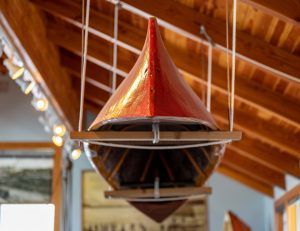Hanging from the rafters, inside the Anacortes Museum and Maritime Heritage Center is a traditional Alaska native, cedar dugout canoe, painted red. While it may look like any other old, yet ordinary canoe, this one is not for it became the signature trademark for a local legend to the Anacortes area, a young girl named Betty Lowman. And the canoe’s name? Bijaboji.

In 1931, the U.S. Coast Guard found the solitary canoe floating in the waters off the Juan de Fuca Strait, not far from the Lowman residence. After a fair amount of time and no one to claim it, Ray Lowman, Betty’s father, acquired it, brought it home and fixed it up for his daughter’s 18th birthday. Her four brothers chipped in on the gift, painting it red, upgrading it with four oak ribs and fitting it with oarlocks. Betty ended up naming the canoe after her four brothers Bill, Jack, Bob, Jim, using the first two letters of their names to form the acronym and name of her canoe.
At 18, Lowman desired to test her 13-foot canoe out by taking it all the way to Alaska. Her father forbade it, hoping she would forget the idea and requested she attend college first. She did. Four years later in 1937 she graduated from the University of Washington with a degree in journalism.
Following Her Dream
Shortly after, she and Bijaboji embarked on the journey of a lifetime. Growing up along the Salish Sea as well as a fisherman’s daughter, Lowman quickly became accustomed to the outdoors as well as the ebbs and flows of riptides, counter currents and quickly changing winds. She was strong, proving her athletic abilities by swimming the Guemes Channel off of Anacortes at the age of 14. Again, demonstrating her determination, she swam 10 miles between the shores of Anacortes and Cypress Island in preparation for her soon to come canoe journey.

The summer of 1937 found her father working in Ketchikan, as he had many summers before. On June 15, Betty, along with a new college friend Flo, casted off from Guemes Island on their planned voyage to row Bijaboji up the Inside Passage and surprise her father in Ketchikan. The young women were already underway when her father caught wind of her plan. Needless to say, he was none too pleased. In fact, he alerted the U.S. Coast Guard, instructing them to escort her home. If they caught up to her.
Unfortunately, after a week in, Flo had to abort the trip due to a bad reaction to the smallpox vaccine she had right before embarking on the journey, leaving Lowman to row Bijaboji solo.
Lowman’s memoir opens on this day in June of 1937, as she began a 66-day adventure fulfilling her quest for challenges, love of the sea and her dreams as an explorer.
Like another woman of the era, Amelia Earhart, Lowman pushed the boundaries for women succeeding in a man’s world. The news of Amelia Earhart’s disappearance dominated the radio broadcasts as Lowman relished her time communing with nature. Yet, unbeknown to Lowman, her escapade began to make a splash of its own, securing newspaper articles and media attention up and down the British Columbia coastline. She was dubbed the “The co-ed canoeist” by some. Sometimes fishermen she encountered called her “the girl with the red canoe.” The journey of Betty and Bijaboji slowly became famous throughout the remote fishing encampments, native villages and eventually made its way back to her hometown of Anacortes. Lowman was becoming a local legend.

Her rowing expedition faced it’s share of challenges along the way, from a gale force wind and dense fog in Queen Charlotte Strait—one of the more dangerous crossings of the voyage—to swamping her canoe, losing everything but her dugout and her sleeping bag.
Yet, despite those adversities, Lowman acquired friends everywhere she went. She made fast buddies of the crew aboard a trawling vessel who rescued her from a foggy night by offering her a tow to the lighthouse keeper and providing a hot meal. Lowman became a star, or maybe a sea star.
Her genuine charm enchanted all and continues to shine brightly, decades later, through her words on the pages of her beautifully told memoir, “North To Alaska By Oar, BijaboJi.” One read and you will fall in love with Betty Lowman, cheer on her crazy adventures and cherish the little red canoe.
Completing 1,300 miles, Lowman pulled into Ketchikan on August 19, 1937, 66-days after casting off the North Beach of Guemes Island. She returned to Anacortes aboard her fathers fishing vessel the Una Mae, already a local celebrity. A unique summer, a unique vacation and a very remarkable young woman.
There is film footage of Lowman’s heralding return archived at the Anacortes Museum and Maritime heritage Center, as well as notebooks filled with articles depicting her adventures. The quaint museum is worth a stop even if it is to just pay homage to Bijaboji. It is also an opportunity to purchase a copy of “North To Alaska By Oar.” A decision well made if you wish to read Lowman’s story for yourself.
The museum is located at 703 R Avenue, Anacortes with the Lowman House just a three-minute walk away. It can be found at 701 K avenue, Anacortes.





































